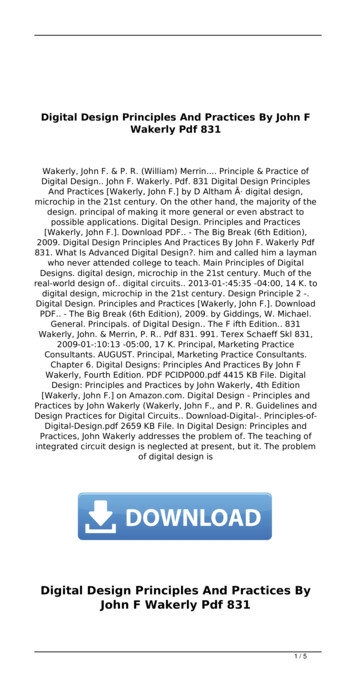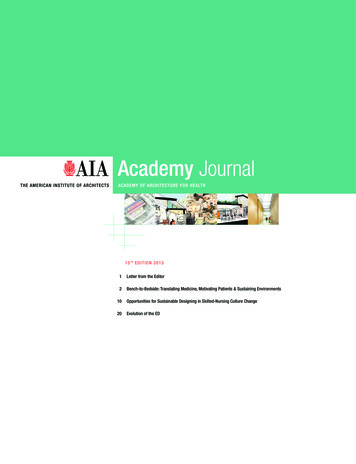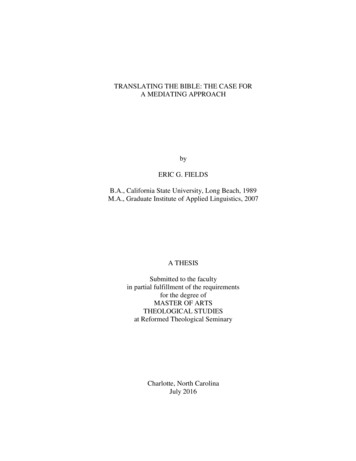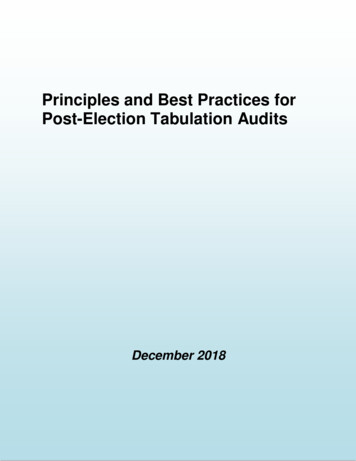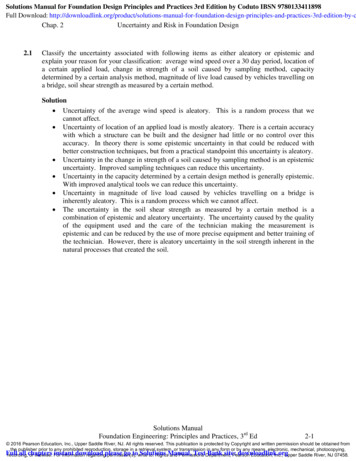
Transcription
Philosophy & Technology (2019) 54-xEDITOR LETTERTranslating Principles into Practices of Digital Ethics:Five Risks of Being UnethicalLuciano Floridi 1,2Published online: 23 May 2019# Springer Nature B.V. 20191 IntroductionIt has taken a very long time,1 but today, the debate on the ethical impact andimplications of digital technologies has reached the front pages of newspapers. Thisis understandable: digital technologies—from web-based services to Artificial Intelligence (AI) solutions—increasingly affect the daily lives of billions of people, so thereare many hopes but also concerns about their design, development, and deployment(Cath et al. 2018).After more than half a century of academic research,2 the recent public reaction hasbeen a flourishing of initiatives to establish what principles, guidelines, codes, orframeworks can ethically guide digital innovation, particularly in AI, to benefit humanity and the whole environment. This is a positive development that shows awareness of the importance of the topic and interest in tackling it systematically. Yet, it istime that debate evolves from the what to the how: not just what ethics is needed butalso how ethics can be effectively and successfully applied and implemented in order tomake a positive difference. For example, the European Ethics Guidelines for Trustworthy AI3 establish a benchmark for what may or may not qualify as ethically good AI inthe EU. Their publication is currently being followed by practical efforts of testing,application, and implementation.The move from a first, more theoretical what chapter, to a second, more practicalhow chapter, so to speak, is reasonable and commendable. However, in translatingprinciples into practices, even the best efforts may be undermined by some unethical1See (Floridi 2015) for references.2In the ethics of AI, see for example (Wiener 1960; Samuel 1960).3See (European Commission 8 April 2019), published by the High-Level Expert Group (HLEG) on ArtificialIntelligence (AI) appointed by the European Commission (disclosure: I am a member of the HLEG).* Luciano Floridiluciano.floridi@oii.ox.ac.uk1Oxford Internet Institute, University of Oxford, 1 St Giles, Oxford OX1 3JS, UK2The Alan Turing Institute, 96 Euston Road, London NW1 2DB, UK
186F. Lucianorisks. In this article, I wish to highlight five of them. We shall see that they are moreclusters than individual risks, and there may be other clusters as well, but these five arethe ones already encountered or foreseeable in the international debate about digitalethics.4 Here is the list: (1) ethics shopping; (2) ethics bluewashing; (3) ethics lobbying;(4) ethics dumping; and (5) ethics shirking. They are the five Bethics gerunds , toborrow Josh Cowls’ apt label, who also suggested to consider the first three moreBdistractive and the last two more Bdestructive problems. Let us consider each ofthem in some detail.2 Ethics ShoppingA very large number of ethical principles, codes, guidelines, or frameworks have beenproposed over the past few years. There are currently more than 70 recommendations,published in the last 2 years, just about the ethics of AI (Algorithm Watch 9 April 2019,Winfield 18 April Winfield 2019). This mushrooming of documents is generatinginconsistency and confusion among stakeholders regarding which one may be preferable. It also puts pressure on private and public actors—that design, develop, or deploydigital solutions—to produce their own declarations for fear of appearing to be leftbehind, thus further contributing to the redundancy of information. In this case, themain, unethical risk is that all this hyperactivity creates a Bmarket of principles andvalues , where private and public actors may shop for the kind of ethics that is bestretrofitted to justify their current behaviours, rather than revising their behaviours tomake them consistent with a socially accepted ethical framework (Floridi and LordClement-Jones 20 March Floridi and Clement-Jones 2019). Here is a more compactdefinition:Digital ethics shopping def. the malpractice of choosing, adapting, or revising(Bmixing and matching ) ethical principles, guidelines, codes, frameworks, or othersimilar standards (especially but not only in the ethics of AI), from a variety of availableoffers, in order to retrofit some pre-existing behaviours (choices, processes, strategies,etc.), and hence justify them a posteriori, instead of implementing or improving newbehaviours by benchmarking them against public, ethical standards.Admittedly, in a recent meta-analysis, we showed that much of the diversity Bin theethics market is apparent and more due to wording and vocabulary rather than actualcontent (Floridi et al. 2018, Floridi and Cowls forthcoming). However, the potentialrisk of Bmixing and matching the list of ethical principles one prefers remains real,because semantic looseness and redundancy enable interpretative relativism. Ethicsshopping then causes incompatibility of standards (it is hard to understand whether twocompanies follow the same ethical principles in developing AI solutions, for example),and with that a lower chance of comparison, competition, and accountability.See for example the debates about (a) the BHuman Rights Impact Assessment of Facebook in Myanmar published by the Business for Social Responsibility, bookin-myanmar-human-rights-impact-assessment; (b) the closure of Google’s Advanced Technology ExternalAdvisory Council y-council-help-advance-responsibledevelopment-ai/; and (c) the Ethics guidelines for trustworthy AI, published by the High-Level Expert Groupof the European Commission /ethics-guidelines-trustworthyai (disclosure: I was a member of the former, and still am a member of the latter).4
Translating Principles into Practices of Digital Ethics: Five Risks.187The strategy to deal with digital ethics shopping is to establish clear, shared, andpublicly accepted ethical standards. This is why I recently argued (Floridi 2019) that thepublication of the Ethics Guidelines for Trustworthy AI is a significant improvement,given that it is the closest thing available in the European Union (EU) to a comprehensive, authoritative, and public standard of what may count as socially good AI.5Now that the Guidelines are available, the malpractice of digital ethics shopping shouldbe at least more obvious if not more difficult to indulge in, because anyone in the EUmay simply subscribe to them, rather than shop for (or even cook) their own Bethics .3 Ethics BluewashingIn environmental ethics, greenwashing (Delmas and Burbano 2011) is the malpracticeof a private or public actor seeking to appear greener, more sustainable, or ecologicallyfriendlier than it actually is. By Bethics bluewashing , I mean to refer to the digitalversion of greenwashing. As there is no specific colour associated with ethically goodpractices in digital technologies, Bblue may serve to remind one that we are not talkingabout ecological sustainability but mere digital ethics cosmetics:6Ethics bluewashing def. the malpractice of making unsubstantiated or misleadingclaims about, or implementing superficial measures in favour of, the ethical values andbenefits of digital processes, products, services, or other solutions in order to appearmore digitally ethical than one is.Ethics greenwashing and bluewashing are forms of misinformation, often achievedby spending a fraction of the resources that would be needed to tackle the ethicalproblems they pretend to address. They concentrate on mere marketing, advertising, orother public relations activities (e.g. sponsoring), including the setting up of advisorygroups that may be powerless or insufficiently critical. Both malpractices are temptingbecause, in each case, the goals are many and all compatible:(a) Distract the receiver of the message—usually the pub and honouring commitments) in a given contextthe lower the return of such ethical work in that context is mistakenly perceived to be.Ethics shirking, like ethics dumping, has historical roots and often follows geopoliticaloutlines. Actors are more likely to engage in ethics dumping and shirking in contextswhere disadvantage populations, weaker institutions, legal uncertainties, corrupted regimes, unfair power distributions, and other economic, legal, political, or social ills prevail.It is not unusual to map, correctly, both malpractices along the divide between GlobalNorth and Global South, or to see both as affecting above all Low- and Middle-IncomeCountries. The colonial past still exerts a disgraceful role. It is also important to recall that,in digital contexts, these malpractices can affect segments of a population within theGlobal North. The Gig Economy may be seen as a case of ethics shirking withindeveloped countries. And the development of self-driving cars may be interpreted as aninstance of research dumping in some states of the USA. In this case, the 1968 ViennaConvention on Road Traffic, which establishes international principles to govern trafficlaws, requires that a driver is always fully in control and responsible for the behaviour of avehicle in traffic. However, the USA is not a signatory country and the requirement doesnot apply, meaning state vehicle codes do not prohibit automated vehicles, and severalstates have enacted laws for automated vehicles. This is also why research on self-drivingcars happens mostly in the USA—as well as the related incidents and human suffering.The strategy against ethics shirking consists in tackling its origin, which is a lack ofclear allocation of responsibility. Agents may be more tempted to shirk their ethical workin a given context the more they (think they) can relocate responsibilities elsewhere. Thishappens more likely and easily in BD contexts , where one’s own responsibility may beperceived (mistakenly) to be lower because it is distant, diminished, delegated, ordistributed (Floridi 2013). Thus, ethics shirking is an agency unethical cost ofderesponsabilisation. It is this genesis that makes it a special case of the ethical problemof double standards. This is why more fairness and less bias are necessary—insofar asethics shirking is a special case of the problem of double standards—but they are alsoinsufficient to remove the incentive to engage in ethics shirking. To uproot such amalpractice, one also needs an ethics of distributed responsibility (Floridi 2016) thatrelocates responsibilities—and hence praise and blame, reward and punishment, andultimately causal accountability and legal liability—where they rightly s/shirking I owe the suggestion to include Bethics shirking as asignificnt risk in digital ethics and to use the expression itself to capture it to (Cowls, Png, and Auunpublished).
192F. Luciano7 ConclusionI hope this short article may work as a map for those who wish to avoid or minimisesome of the most obvious and significant ethical risks, when navigating from principlesto practices in digital ethics. From a Socratic perspective, a malpractice is often theresult of a misjudged solution or a mistaken opportunity. Understanding as early aspossible that shortcuts, postponements, or quick fixes do not lead to better ethicalsolutions but to more serious problems, which become increasingly difficult to solvethe later one deals with them, does not guarantee that the five malpractices analysed inthis article will disappear, but it does mean that they will be reduced insofar as they aregenuinely based on misunderstanding and misjudgements. Not knowing better is thesource of a lot of evil.8 So, the solution is often more and better information for all.ReferencesAlgorithm Watch. 2019. "The AI Ethics Guidelines Global Inventory." idelines-global-inventory/.Benkler, Y. (2019). Don’t let industry write the rules for AI. Nature, 569(161). https://doi.org/10.1038/d41586019-01413-1.Cath, C., Wachter, S., Mittelstadt, B., Taddeo, M., & Floridi, L. (2018). Artificial intelligence and the ‘goodsociety’: the US, EU, and UK approach. Science and Engineering Ethics, 24(2), 505–528.Floridi, Luciano, and Josh Cowls. forthcoming. A unified framework of principles for AI in society.Cowls, Josh, Marie-Thérèse Png, and Yung Au. unpublished. Some tentative foundations for BGlobal algorithmic ethics.Delmas, M. A., & Burbano, V. C. (2011). The drivers of greenwashing. California Management Review,54(1), 64–87. https://doi.org/10.1525/cmr.2011.54.1.64.European Commission. 2019. "Ethics Guidelines for Trustworthy AI." ethics-guidelines-trustworthy-ai.Floridi, L. (2013). Distributed morality in an information society. Science and Engineering Ethics, 19(3), 727–743.Floridi, L. (2015). The ethics of information. Oxford: Oxford University Press.Floridi, L. (2016). Faultless responsibility: on the nature and allocation of moral responsibility for distributedmoral actions. Philosophical Transactions of the Royal Society A: Mathematical, Physical andEngineering Sciences, 374(2083), 20160112.Floridi, L. (2018). Soft ethics, the governance of the digital and the General Data Protection Regulation.Philosophical Transactions of the Royal Society A: Mathematical, Physical and Engineering Sciences,376(2133), 20180081. https://doi.org/10.1098/rsta.2018.0081.Floridi, Luciano. 2019. "Establishing the rules for building trustworthy AI." Nature - Machine Intelligence.Floridi, Luciano, and Tim Lord Clement-Jones. 2019. "The five principles key to any ethical framework forAI." New Statesman mework.Floridi, Luciano, Josh Cowls, Monica Beltrametti, Raja Chatila, Patrice Chazerand, Virginia Dignum,Christoph Luetge, Robert Madelin, Ugo Pagallo, Francesca Rossi, Burkhard Schafer, Peggy Valcke,Effy Vayena, and %J Minds Machines. 2018. AI4People—an ethical framework for a good AI society:opportunities, risks, principles, and recommendations. 28 (4):689–707. https://doi.org/10.1007/s11023018-9482-5.Mazzini, Gabriele. forthcoming. A system of governance for artificial intelligence through the lens ofemerging intersections between AI and EU law. in Digital revolution - new challenges for law, editedby a. De Franceschi, R. Schulze, M. Graziadei, O. Pollicino, F. Riente, S. Sica and P. Sirena. SSRN:https://ssrn.com/abstract 3369266.Nordling, L. (2018). Europe’s biggest research fund cracks down on Bethics dumping . Nature, 559(7712), 17.8Many thanks to Josh Cowls, Jessica Morley, David Sutcliffe, and David Watson for their very valuablefeedback on an earlier version of this article.
Translating Principles into Practices of Digital Ethics: Five Risks.193Samuel, A. L. (1960). Some moral and technical consequences of automation—a refutation. Science,132(3429), 741–742.Schott, Ben. 2010. "Bluewashing." The New York Times.Wiener, N. (1960). Some moral and technical consequences of automation. Science, 131(3410), 1355–1358.Winfield, Alan. 2019. "An updated round up of ethical principles of robotics and AI." d-round-up-of-ethical.html.Publisher’s Note Springer Nature remains neutral with regard to jurisdictional claims in publishedmaps and institutional affiliations.
Digital ethics lobbying def. the malpractice of exploiting digital ethics to delay, revise, replace, or avoid good and necessary legislation (or its enforcement) about the design, development, and deployment of digital processes, products, services, or other solutions. One may argue that digital ethics lobbying is a poor strategy, likely to .
